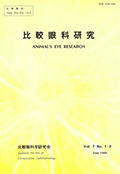Volume 7, Issue 1-2
Displaying 1-8 of 8 articles from this issue
- |<
- <
- 1
- >
- >|
Lecture and Reports at 7th Symposium on Some Problems in the Field of Comparative Ophthalmology
Special Lecture
-
1988 Volume 7 Issue 1-2 Pages 1-6
Published: 1988
Released on J-STAGE: December 25, 2020
Download PDF (1919K)
Reports
-
1988 Volume 7 Issue 1-2 Pages 7-10
Published: 1988
Released on J-STAGE: December 25, 2020
Download PDF (950K) -
1988 Volume 7 Issue 1-2 Pages 11-14
Published: 1988
Released on J-STAGE: December 25, 2020
Download PDF (1243K) -
1988 Volume 7 Issue 1-2 Pages 15-19
Published: 1988
Released on J-STAGE: December 25, 2020
Download PDF (1436K)
-
1988 Volume 7 Issue 1-2 Pages 21-25
Published: 1988
Released on J-STAGE: December 25, 2020
Download PDF (1077K) -
1988 Volume 7 Issue 1-2 Pages 27-29
Published: 1988
Released on J-STAGE: December 25, 2020
Download PDF (735K)
Original Report
-
1988 Volume 7 Issue 1-2 Pages 31-37
Published: 1988
Released on J-STAGE: December 25, 2020
Download PDF (1719K)
Technical Reports
-
1988 Volume 7 Issue 1-2 Pages 39-42
Published: 1988
Released on J-STAGE: December 25, 2020
Download PDF (1142K)
- |<
- <
- 1
- >
- >|
